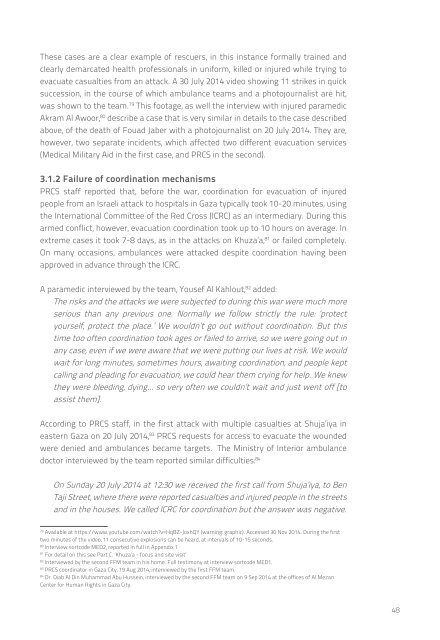HHo0s
HHo0s
HHo0s
Create successful ePaper yourself
Turn your PDF publications into a flip-book with our unique Google optimized e-Paper software.
These cases are a clear example of rescuers, in this instance formally trained andclearly demarcated health professionals in uniform, killed or injured while trying toevacuate casualties from an attack. A 30 July 2014 video showing 11 strikes in quicksuccession, in the course of which ambulance teams and a photojournalist are hit,was shown to the team. 79 This footage, as well the interview with injured paramedicAkram Al Awoor, 80 describe a case that is very similar in details to the case describedabove, of the death of Fouad Jaber with a photojournalist on 20 July 2014. They are,however, two separate incidents, which affected two different evacuation services(Medical Military Aid in the first case, and PRCS in the second).3.1.2 Failure of coordination mechanismsPRCS staff reported that, before the war, coordination for evacuation of injuredpeople from an Israeli attack to hospitals in Gaza typically took 10-20 minutes, usingthe International Committee of the Red Cross (ICRC) as an intermediary. During thisarmed conflict, however, evacuation coordination took up to 10 hours on average. Inextreme cases it took 7-8 days, as in the attacks on Khuza’a, 81 or failed completely.On many occasions, ambulances were attacked despite coordination having beenapproved in advance through the ICRC.A paramedic interviewed by the team, Yousef Al Kahlout, 82 added:The risks and the attacks we were subjected to during this war were much moreserious than any previous one. Normally we follow strictly the rule: ‘protectyourself, protect the place.’ We wouldn’t go out without coordination. But thistime too often coordination took ages or failed to arrive, so we were going out inany case, even if we were aware that we were putting our lives at risk. We wouldwait for long minutes, sometimes hours, awaiting coordination, and people keptcalling and pleading for evacuation, we could hear them crying for help. We knewthey were bleeding, dying… so very often we couldn’t wait and just went off [toassist them].According to PRCS staff, in the first attack with multiple casualties at Shuja’iya ineastern Gaza on 20 July 2014, 83 PRCS requests for access to evacuate the woundedwere denied and ambulances became targets. The Ministry of Interior ambulancedoctor interviewed by the team reported similar difficulties: 84On Sunday 20 July 2014 at 12:30 we received the first call from Shuja’iya, to BenTaji Street, where there were reported casualties and injured people in the streetsand in the houses. We called ICRC for coordination but the answer was negative.79Available at https://www.youtube.com/watch?v=HqBZ-JoxhQY (warning: graphic). Accessed 30 Nov 2014. During the firsttwo minutes of the video, 11 consecutive explosions can be heard, at intervals of 10-15 seconds.80Interview sortcode MED2, reported in full in Appendix 181For detail on this see Part C. ‘Khuza’a - focus and site visit’82Interviewed by the second FFM team in his home. Full testimony at interview sortcode MED1.83PRCS coordinator in Gaza City, 19 Aug 2014, interviewed by the first FFM team.84Dr. Diab Al Din Muhammad Abu Hussein, interviewed by the second FFM team on 9 Sep 2014 at the offices of Al MezanCenter for Human Rights in Gaza City.48


